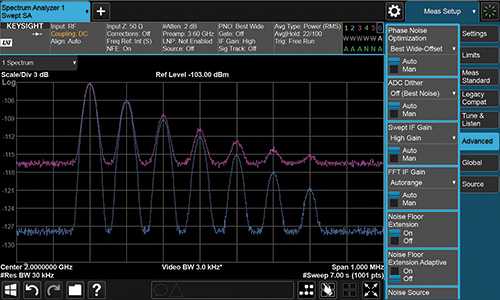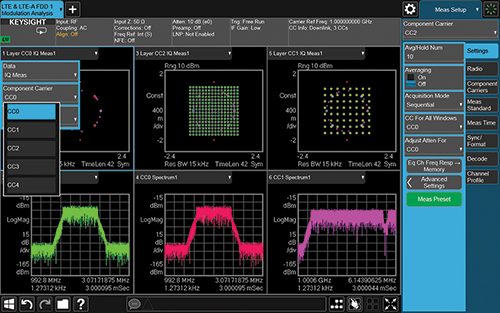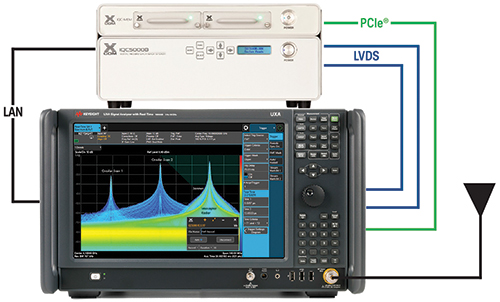
In technology, changes that occur over a long period of time are often based on a broad range of innovations. As a result, the actual extent of the transformation is clear only in retrospect. Such is the case with the evolution of spectrum and signal analyzers. The biggest changes are in the block diagram. Through the increasing performance of high speed digitizers, digital filters and fast Fourier transform (FFT) technology, the intermediate frequency (IF) section has evolved from scalar to vector. Increasingly, this reflects the nature of the signals and systems many engineers must measure. The other important transformations are in the user interface (UI) and associated user experience. Today, the touch-enabled UI technology widely used in smartphones, tablets and PCs can be readily adapted to the large displays that are increasingly common in signal analyzers. Consequently, analyzers now provide new levels of interaction that enable intuitive connections between cause and effect during development, debugging and troubleshooting.
Technology to Suit the User
Over the past 20 years, changing technologies have driven departures from the familiar “swept spectrum analyzer” paradigm. The first big departure occurred in the early 1990s, with the advent of vector signal analyzers (VSA). About 10 years later, benchtop real-time spectrum analyzers (RTSA) produced another shift. Compared to traditional spectrum analyzers, these new instruments operated differently, made different measurements and produced different displays. For some end users, the differences proved to be a substantial barrier to acceptance and adoption.
The technology in the latest Keysight X-Series signal analyzers is designed to bend those trends in ways that make virtually every measurement task simpler and faster. This has been accomplished in two ways: first, through the use of a single analyzer to cover swept, vector and real-time signal analysis. This convergence addresses the real needs of RF engineers who may need one or more of these capabilities on any given day. The second change is based on simplified measurement set-up and analyzer operation in whichever mode the engineer chooses to use. With touch capability, access to rich functionality in measurement, display and analysis no longer requires a deep, complex hardkey/softkey UI.
Enabling Accessible Performance
Each X-Series signal analyzer has a large display with multi-touch functionality similar to that of a tablet (a 14.1" diagonal display in the UXA, 10.6" with the others). Measurement settings and displays are easily controlled using familiar gestures, such as single or double tapping to select a parameter or expand a window, dragging and pinching to zoom and scale a display and using press-and-hold to access context-sensitive selections.
The intuitive power of the swept-analyzer paradigm remains. A single touch of an in-display menu panel, measurement bar, annotation hotspot or drop-down window provides direct access to major parameters, whether the task is simple spectrum analysis or complex digital demodulation (see Figure 1). With any of the new X-Series analyzers, it takes no more than two touches to complete most operations. This enables rapid navigation of display capabilities and analysis functions without abandoning the natural feel of a swept analyzer when making basic spectrum measurements.

Figure 1 A single press on the menu panel provides direct access to capabilities such as Keysight’s Noise Floor Extension (NFE) technology, which yields an improvement of up to 12 dB in the spectrum analysis noise floor.
As signals and tests become increasingly complex, engineers often face a steep learning curve. In a signal analyzer, there are two ways to mitigate this problem: minimizing change from the familiar usage model and using the same UI, measurement applications and programming commands across multiple measurement platforms. There are five models in the X-Series: UXA, PXA, MXA, EXA and CXA. The shared internal architecture includes a measurement abstraction layer that, wherever possible, shields the front-panel user or instrument programmer from any internal hardware differences and complexities. This yields one key benefit: with consistent operation and programming across the family, learning one X-Series analyzer means knowing them all.
When used in any mode — spectrum analyzer, RTSA or measurement application — the large touch screen and multi-trace displays make it easier for engineers to create multiple, simultaneous views of complex signals (see Figure 2). These views leverage the engineer’s own knowledge and help identify cause-and-effect, even when signal behavior is complex and timing relationships are unknown.

Figure 2 Drop-down windows enable quick configuration of an LTE-A FDD ETC transmitter measurement, including 256-QAM demodulation.
As with the UI, the five X-Series analyzers share a variety of applications that are proven, ready-to-use measurements for signal analysis. Examples range from parametric measurements such as phase noise and noise figure to standards-specific analysis of LTE/LTE-Advanced and W-CDMA signals. Across all five models, the use of consistent measurements, algorithms and controls produces repeatable results that reveal the performance of devices and designs. The X-Series family is also compatible with Keysight’s 89600 VSA software, which provides a comprehensive set of tools for demodulation and vector signal analysis. The software also provides connections to the simulation capabilities of electronic design automation (EDA) software, such as Keysight’s ADS and SystemVue platforms.
Improving Measurement Quality
An enhanced UI is even more valuable if the underlying measurements have also evolved. Inside the X-Series signal analyzers, recent advances in digital technologies have made their way into the local oscillator (LO) section. Keysight designed and developed an RF-optimized digital-to-analog converter (DAC) that is the core of a direct digital synthesizer (DDS) that is used in the LO of the UXA and PXA models. Because the LO is used in all frequency conversion operations, its purity and stability are reflected in the spurious and phase noise specifications of both models. For medium and narrow frequency offsets, the DDS LO is used alone. One key benefit is elimination of the typical pedestal that appears in the phase noise floor of analyzers that rely solely on phase-locked loop (PLL) technology. For wider frequency offsets, the DDS LO is used in conjunction with a YIG-based PLL to yield additional improvements in phase noise.
To address new and emerging wideband applications, the UXA now offers a maximum analysis bandwidth of 1 GHz with automatically-applied frequency response corrections. Because this capability is integrated into the analyzer, it is more convenient than commercial or do-it-yourself systems that require multiple instruments. Those who chase after elusive and intermittent signals can configure the PXA or UXA for gap-free sampling and internal recording at analysis bandwidths up to 510 MHz. To facilitate the acquisition of dynamic signals, the RTSA mode supports frequency mask and time-qualified triggering functions that respond to user-specified signal behaviors.
A PXA or UXA can also be configured to serve as the core of a turnkey RF streaming solution (see Figure 3). Through a high speed PCI Express digital interface, either analyzer can stream complex-valued I/Q data at a maximum real-time rate of 255 MHz to the IQC5255B signal record-and-playback unit from X-COM Systems. The IQC5255B is available with 2 or 4 TB of onboard memory, and it also supports external RAID arrays of up to 15 TB, which can store more than three hours of gap-free data at the maximum 255 MHz bandwidth.

Figure 3 Combining the UXA signal analyzer and IQC5255B recorder with the X-COM Spectro-X and Keysight 89600 VSA software applications creates a comprehensive solution for RF streaming.
Within the X-Series, each model occupies a distinct place in a price/performance curve: the essential measurements of the CXA, the cost effectiveness of the EXA, the wireless focus of the MXA, the benchmark performance of the PXA and the wide open performance of the UXA. In addition, each analyzer incorporates digital technologies that provide yet another useful benefit: future upgradeability. Initially, an engineer can select the level of performance and optional capabilities needed to match specific requirements, such as frequency coverage, analysis bandwidth, phase noise and noise floor. As requirements change, additional or enhanced capabilities are easy to add. These levels of inherent flexibility and future adaptability are essential attributes of every tool an RF engineer may choose to use.
Keysight Technologies
Santa Rosa, Calif.
www.keysight.com/find/X-Series
